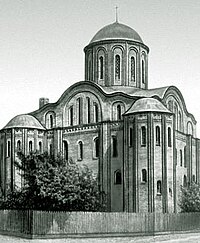- For another person with the same name, see Rurik Rostislavich (died 1092)
This article needs additional citations for
verification. (January 2023) |
Rurik Rostislavich, also spelt Riurik [1] ( Russian and Ukrainian: Рюрик Ростиславич; died 1215) was Prince of Novgorod (1170–1171), Belgorod Kievsky (1173–1194), Grand Prince of Kiev (1173; [1] 1180–1181; 1194–1201; 1203–1204; 1205-1206; 1207–1210),[ citation needed] and Prince of Chernigov (1210–1214).

Life
Rurik was the son of Rostislav I of Kiev. [2] Succession conflicts intermittently placed Rurik on the throne of the Kievan Rus' no fewer than six times between 1173 and 1210. [3]
According to the Kievan Chronicle account, [4] in 1182,[ citation needed] Rurik became co-ruler with Sviatoslav III Vsevolodovich of Kiev (who had become prince of Kiev in 1177 [5]), a " duumvirate" arrangement that lasted until Sviatoslav's death in 1194. [6] According to the Novgorod Fourth Chronicle and Sofia First Chronicle tradition sub anno 6688 (1180) and 6693 (1185), Sviatoslav reigned alone, and there is no mention of Rurik as co-prince. [7]
Rurik ruled alone until 1199, when his rule was challenged by Roman the Great, who deposed Rurik.[ citation needed]
After a brief stint in Chernigov, where he built the Church of St. Paraskebas,[ citation needed] Rurik, along with his kinsmen and a Cuman army, attacked and sacked Kiev in 1203, [8] but was repelled until Roman's death in 1205.[ citation needed] Rurik had been confined to a monastery in 1204, but he abandoned his holy vows and returned to the throne.[ citation needed]
His cousin, Vsevolod, felt that Rurik's previous monastic vows rendered his authority invalid, and so attacked and briefly seized Kiev in 1206, 1207, and 1211.[ citation needed] He succeeded in capturing Rurik, who died in captivity in Chernigov.[ citation needed]
Rurik was married to Anna of Turov; among their children was Rostislav II of Kiev.[ citation needed]
References
- ^ a b Martin 2007, p. 128.
- ^ Lenhoff 2015, p. 18.
- ^ Ostrowski 2018, p. 36.
- ^ Martin 2006, pp. 277–278.
- ^ Martin 2006, p. 277.
- ^ Martin 2007, p. 130.
- ^ Martin 2006, p. 278.
- ^ Magocsi 2010, p. 124.
Sources
- Lenhoff, Gail (2015). "Rus'-Tatar Princely Marriages in the Horde: The Literary Sources". Russian History. 42 (1, Festschrift for Janet Martin). Brill. doi: 10.1163/18763316-04201004. S2CID 211599594.
- Martin, Janet (2006). "Calculating Seniority and the Contests for Succession in Kievan Rus'". Russian History. 33 (2/4). Brill: 267–281. ISSN 1876-3316. JSTOR 24664444.
- Martin, Janet (2007). Medieval Russia: 980–1584. Second Edition. E-book. Cambridge: Cambridge University Press. ISBN 978-0-511-36800-4.
- Magocsi, Paul Robert (2010). A History of Ukraine: The Land and Its Peoples. Toronto: University of Toronto Press. p. 894. ISBN 9781442610217. Retrieved 22 January 2023.
- Ostrowski, Donald (2018). "Was There a Riurikid Dynasty in Early Rus'?". Canadian-American Slavic Studies. 52 (1): 30–49. doi: 10.1163/22102396-05201009.
- For another person with the same name, see Rurik Rostislavich (died 1092)
This article needs additional citations for
verification. (January 2023) |
Rurik Rostislavich, also spelt Riurik [1] ( Russian and Ukrainian: Рюрик Ростиславич; died 1215) was Prince of Novgorod (1170–1171), Belgorod Kievsky (1173–1194), Grand Prince of Kiev (1173; [1] 1180–1181; 1194–1201; 1203–1204; 1205-1206; 1207–1210),[ citation needed] and Prince of Chernigov (1210–1214).

Life
Rurik was the son of Rostislav I of Kiev. [2] Succession conflicts intermittently placed Rurik on the throne of the Kievan Rus' no fewer than six times between 1173 and 1210. [3]
According to the Kievan Chronicle account, [4] in 1182,[ citation needed] Rurik became co-ruler with Sviatoslav III Vsevolodovich of Kiev (who had become prince of Kiev in 1177 [5]), a " duumvirate" arrangement that lasted until Sviatoslav's death in 1194. [6] According to the Novgorod Fourth Chronicle and Sofia First Chronicle tradition sub anno 6688 (1180) and 6693 (1185), Sviatoslav reigned alone, and there is no mention of Rurik as co-prince. [7]
Rurik ruled alone until 1199, when his rule was challenged by Roman the Great, who deposed Rurik.[ citation needed]
After a brief stint in Chernigov, where he built the Church of St. Paraskebas,[ citation needed] Rurik, along with his kinsmen and a Cuman army, attacked and sacked Kiev in 1203, [8] but was repelled until Roman's death in 1205.[ citation needed] Rurik had been confined to a monastery in 1204, but he abandoned his holy vows and returned to the throne.[ citation needed]
His cousin, Vsevolod, felt that Rurik's previous monastic vows rendered his authority invalid, and so attacked and briefly seized Kiev in 1206, 1207, and 1211.[ citation needed] He succeeded in capturing Rurik, who died in captivity in Chernigov.[ citation needed]
Rurik was married to Anna of Turov; among their children was Rostislav II of Kiev.[ citation needed]
References
- ^ a b Martin 2007, p. 128.
- ^ Lenhoff 2015, p. 18.
- ^ Ostrowski 2018, p. 36.
- ^ Martin 2006, pp. 277–278.
- ^ Martin 2006, p. 277.
- ^ Martin 2007, p. 130.
- ^ Martin 2006, p. 278.
- ^ Magocsi 2010, p. 124.
Sources
- Lenhoff, Gail (2015). "Rus'-Tatar Princely Marriages in the Horde: The Literary Sources". Russian History. 42 (1, Festschrift for Janet Martin). Brill. doi: 10.1163/18763316-04201004. S2CID 211599594.
- Martin, Janet (2006). "Calculating Seniority and the Contests for Succession in Kievan Rus'". Russian History. 33 (2/4). Brill: 267–281. ISSN 1876-3316. JSTOR 24664444.
- Martin, Janet (2007). Medieval Russia: 980–1584. Second Edition. E-book. Cambridge: Cambridge University Press. ISBN 978-0-511-36800-4.
- Magocsi, Paul Robert (2010). A History of Ukraine: The Land and Its Peoples. Toronto: University of Toronto Press. p. 894. ISBN 9781442610217. Retrieved 22 January 2023.
- Ostrowski, Donald (2018). "Was There a Riurikid Dynasty in Early Rus'?". Canadian-American Slavic Studies. 52 (1): 30–49. doi: 10.1163/22102396-05201009.